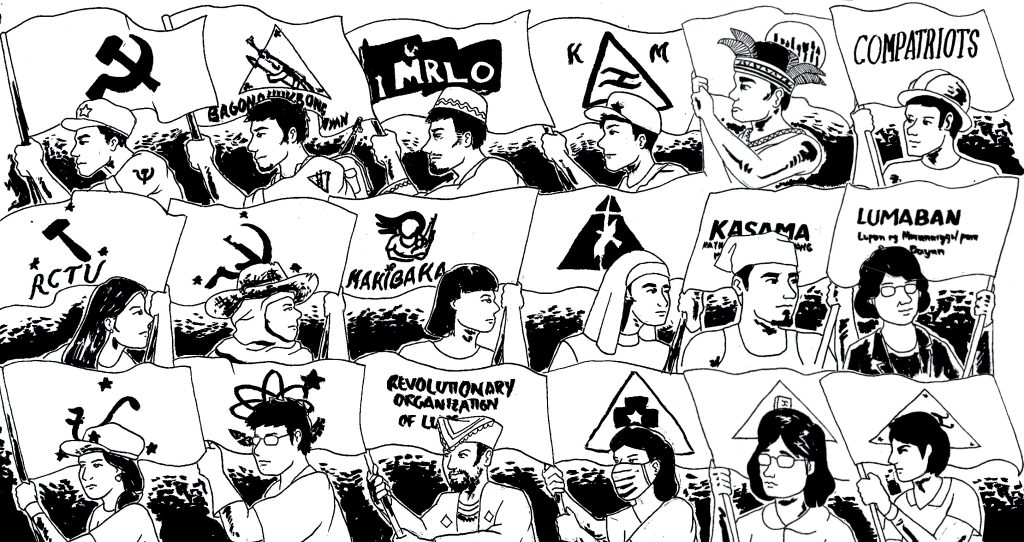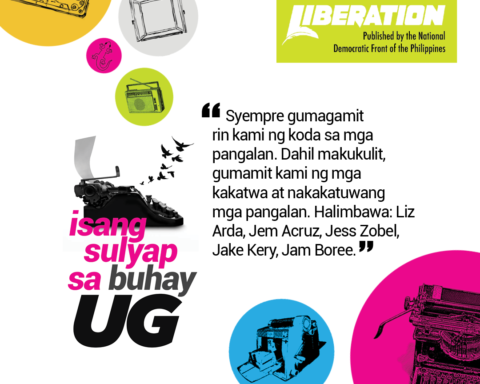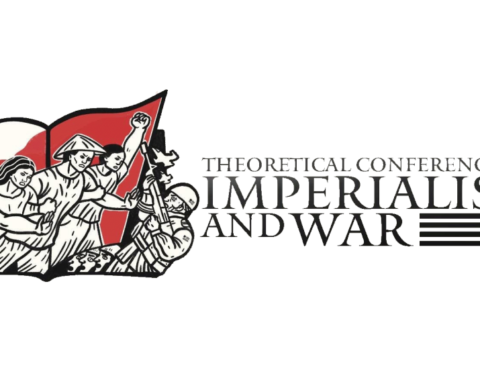Formally launched in 1973 on the initiative of the Communist Party of the Philippines (CPP) shortly after its reestablishment in 1968, the National Democratic Front of the Philippines (NDFP) is the most consolidated underground alliance of revolutionary forces under proletarian leadership. The NDFP brought together, as founding members, national democratic organizations that went underground in 1972 when martial law was declared. Some of these are the Kabataang Makabayan, Christians for National Liberation and the Pambansang Katipunan ng mga Magsasaka (PKM, Federation of Peasants).
Today, the NDFP has gathered 18 revolutionary organizations—cutting across all patriotic classes—even as it continues to draw support and new allies to advance the national democratic revolution and fulfil the Filipino people’s desire for national and social liberation embodied in the CPP’s Program for a People’s Democratic Revolution and the NDFP’s 12-Point Program.
Standing on the basic alliance of workers and peasants—as embodied on the CPP’s absolute leadership of the New People’s Army (NPA)—the NDFP is tasked with developing the revolutionary mass movement in the countryside and in the cities to rally political and material support for the armed struggle being waged by the NPA. Throughout its 50 years, the NDFP allied organizations have deployed Red fighters to the NPA; and not a few of them became commanders.
The NPA is the mass organization to carry out the revolutionary armed struggle, the main form of the people’s struggle. Along with it, the NPA is also tasked to implement and advance agrarian revolution and mass base building towards establishing organs of political power.
Working closely with the NPA is the Pambansang Katipunan ng Magbubukid (PKM), a mass organization of peasants; a deep source of Red commanders and fighters of the NPA. Being the majority class in Philippine society, the peasantry is considered as the main force and the most reliable ally of the proletariat in waging the national democratic revolution (NDR). With the NPA, the PKM have achieved significant victories in agrarian revolution, the main content of the NDR.
Aside from the CPP exercising proletarian leadership in the NDFP, two other revolutionary mass organizations of workers—the Revolutionary Council of Trade Unions (RCTU and semi-workers, the Katipunan ng mga Samahang Manggagawa (KASAMA)—are affiliated with it.
Both RCTU and KASAMA are the wellspring of Party cadres and Red fighters. These organizations ensure the conscientization and advance of the workers movement at the factory or community level through organizing and union building, political education, assertion of their rights, immersion with the masses in the countryside and enhancing solidarity work with progressive workers union abroad.
Patriotic Filipino overseas workers (and their families in the Philippines) are organized into the Compatriots to play the crucial part in advancing the Philippine revolution from where they are all over the globe. Aside from organizing more Filipino workers, they gather support from friendly foreign nationals, both material and political, in support of the armed revolution. Compatriots is the latest addition to the NDFP.
In the countryside, the NPA also organizes the peasantry through the revolutionary organizations of women (Makabayang Kilusan ng Bagong Kababaihan, MAKIBAKA) and youth (Kabataang Makabayan, KM). All in all, these organizations pave the way and ensure that organs of political power are built from the village level upwards.
Additionally, in the villages where there are indigenous peoples and Bangsa Moro, revolutionary organizations such as the Cordillera People’s Democratic Front (CPDF), Moro Resistance Liberation Organization (MRLO), and Revolutionary Organization of Lumad (RoL) are established to ensure that their rights to self-determination and ancestral land are duly recognized, articulated, and fought for.
Although the indigenous peoples and the Bangsa Moro as a social group are part of the classes in Philippine society like the youth, women, and fisherfolk, the revolutionary movement ensures that the particularity of their conditions are given due attention.
Various underground organizations of among the petty-bourgeoisie are also part of the NDFP. With the basic alliance of the working class and the peasantry as a stable foundation, the middle forces—student youth, teachers, low-income professionals and intellectuals—are drawn into the NDFP, both in the cities and in the countryside.
While Kabataang Makabayan plays a vital role in organizing the youth from the working class and the peasantry, it is also tasked to reach out to the student-youth.
The student-youth comprise the majority of the urban petty bourgeoisie along with the low-income professionals and intellectuals, and teachers. They are among the sectors of the petty bourgeoisie who are decisive in shaping favorable public opinion for the Philippine revolution in the whole country. They are the vanguards of cultural revolution and articulators of revolutionary propaganda.
The people’s democratic revolution cannot advance without the participation of revolutionary intellectuals.
Thus, aside from KM, organizations such as the Katipunan ng mga Gurong Makabayan (KAGUMA, KGM) composed of teachers-educators; Artista at Manunulat para sa Sambayanan (ARMAS) an organization of artists, cultural workers and media workers; Christians for National Liberation (CNL) of the religious sector of various denominations and congregations and church workers; Makabayang Samahang Pangkalusugan (MASAPA, MSP) among health practitioners and health workers and medical students; and Liga ng Agham para sa Bayan (LAB) of scientists and technologists can be counted as among most active articulators of a nationalist, scientific and mass-oriented culture and, more importantly, the national democratic aspirations of the people.
Also by mobilizing their members, these organizations work with the Party, the NPA, and other allied organizations in the guerrilla fronts like the PKM to provide and train the NPA and the masses literacy and numeracy as in the case of KAGUMA; health services, education and trainings on basic health care, sanitation, alternative medicine and medical procedure such as surgery by MASAPA; workshops on various fields of arts and literature by ARMAS. LAB provides science and technology education and training and technology-related projects to respond to the needs of the communities and of the NPA in the conduct of the armed struggle. Most, if not all, of these organizations are founding members of the NDFP.
In the 90s onwards, revolutionary organizations such as the Makabayang Kawaning Pilipino (MKP), an underground organization of public service sector employees, workers and middle management in the public service sector and the Lupon ng mga Manananggol para sa Bayan (LUMABAN) of lawyers and law practitioners and students have affiliated with the NDFP.
MKP repudiates the debased bureaucracy dominated by the ruling- class-stooge of US imperialism while LUMABAN is determined to upend the rotten judicial system, the instrument for coercion and repression of the ruling class to perpetuate its power.
The workers and peasantry and the petty bourgeoisie allied with the NDFP, the basic force of the revolution, have contributed not only knowledge, talent, skills, and resources to the revolution but also brawn and valor by actively participating in the armed struggle. (Pat Gambao and Priscilla Guzman)###






